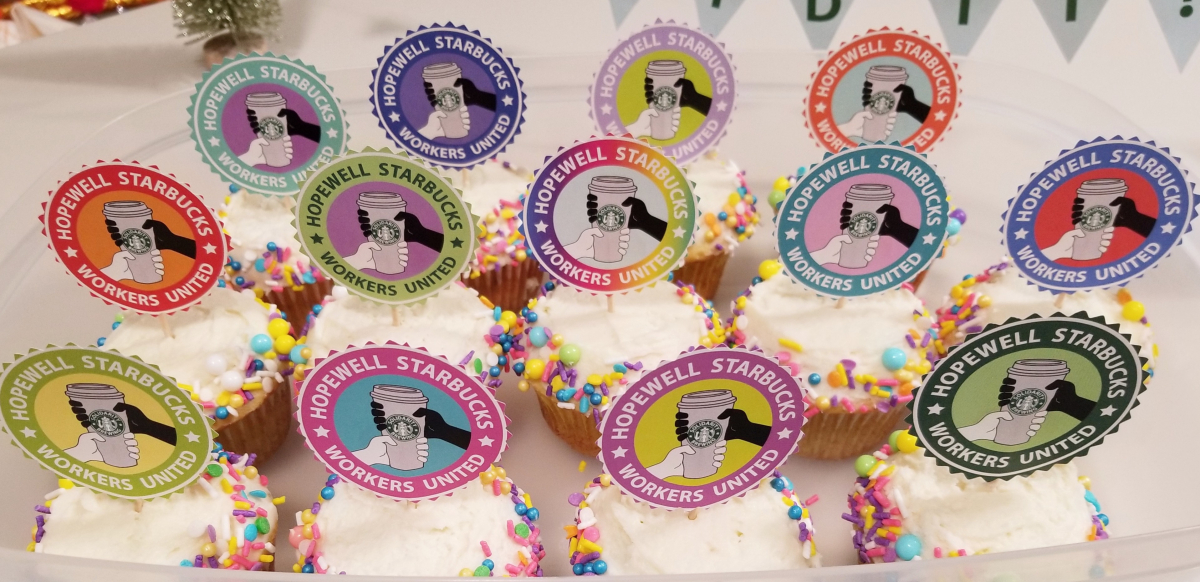How We Turned the Tables On Starbucks Union-Busters

Starbucks is paying millions to a law firm to train managers in union-busting. Workers are not impressed. Photo: Sara Mughal
A national wave of organizing has hit Starbucks' company-run stores in the last three months. The author is among hundreds of Starbucks workers who have filed for elections with the National Labor Relations Board in almost 100 locations since early December when workers in Buffalo won the first union at a company-run location in the United States in decades. —Editors
Let me set the stage for you: A single cheese pizza cut into sixteenths, a small group of chairs awkwardly arranged to a circle, and corporate level managers trying to chat baristas up like we were best friends.
Our store had closed at noon that Tuesday, so that the company could hold four consecutive “store meetings,” each with a group of around six employees. A few weeks before, five workers had to go into isolation due to Covid and the store had barely modified operating hours—but for these meetings we could shut down for almost the entire day.
These were Starbucks’ “listening sessions,” or corporate union-busting meetings workers hoping to unionize their store are forced to participate in. But we at the Hopewell store were prepared.
WE CAME PREPARED
Starbucks is spending millions upon millions of dollars to hire a huge law firm to train its managers to become experts in union-busting. You’d think they’d be better at it. Every store that files goes through the same basic steps of union-busting. The upside of this is that Starbucks workers can see what’s coming, and get creative.
Our store prepared for the meeting not only by communicating with each other, but also by holding a Zoom meeting with baristas from other cities who’d already gone through the same experience. They walked us through what to expect and what kinds of things had worked best for them in throwing the union-busters off their game.
So when we sat down for our meetings with our Store Manager, District Manager, and Regional Manager, we did so in solidarity.
Our manager started off the meeting. This woman had spent a good part of the last election cycle talking about her left-leaning politics. She leads the Starbucks “Womens’ Alliance Network,” a group designed to empower female Starbucks employees. She started our meeting by looking us all in the eyes and saying, “I don’t think you need a union.”
GOING OFF-SCRIPT
Over the next few hours they tried various tactics to try to sow doubt among us. They tried one of the arguments they’ve used frequently, which is that with a union we won’t be able to have baristas from other stores cover shifts at our store. In response, two people pointed to a New Jersey law that specifies that non-union workers can work in union settings.
Our Regional Manager kindly thought of those workers and wondered, “How would that affect their experience? How would they feel working in an environment where their salary is different?” One worker responded, “Well, I’d think that would just spark interest in them unionizing their store too.”
Clearly these managers were operating from a basic script; when we veered away from it, they unskillfully tried to return to it.

SUPPORT LABOR NOTES
BECOME A MONTHLY DONOR
Give $10 a month or more and get our "Fight the Boss, Build the Union" T-shirt.
In the middle of our discussion which had turned into all the positive things our union could help us achieve, our Regional Manager tried to redirect by telling us she was “worried about all the pros and cons she was hearing.” I asked, “I think I missed the cons, what were those again?” She looked annoyed, half-heartedly tried to bring up a previously addressed point, then got quiet.
LONG LIST OF QUESTIONS
Our one-hour session finished on a wonderful note. One worker who doesn’t often feel comfortable enough to speak up in front of managers said, “Since we all decided to do this, we all have more confidence and there’s a lot of hope in the store. We don’t even feel like a team, we feel like a family. I come in and now I’m happy to be here.” All of us agreed with her, and we were all in tears—while the three managers looked on and truly had no idea what to do or say.
When we all discussed our meetings later that day, we found just about every one had gone similarly. Each group of workers had different tactics, but the union-busting managers were thrown off again and again.
The final group had two workers who had decided to prepare lists of questions that spanned multiple sheets of paper. They doubled the length of their meeting to two hours; over and over exasperated managers tried to end their long, unsuccessful day.
I’m certain the goal of the day for these managers was to have us all questioning everything we’ve been working for. Instead, I’m confident they ended their day confused and unsure of where to go next. Perhaps they should have prepared a little more, like we did.
Sara Mughal is a shift supervisor and member of Starbucks Workers United at the Hopewell Starbucks in Pennington, New Jersey.




